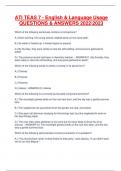Autre
Biology SNAB a-level practical write up - Mineral Ion deficiencies (7)
- Cours
- Établissement
Alevel biology practical write up is a report of a laboratory experiment conducted by students. It is required as part of the assessment for the subject. The a-level biology practical write up document is a professional report and should be organised in a clear and logical manner. It should inc...
[Montrer plus]












